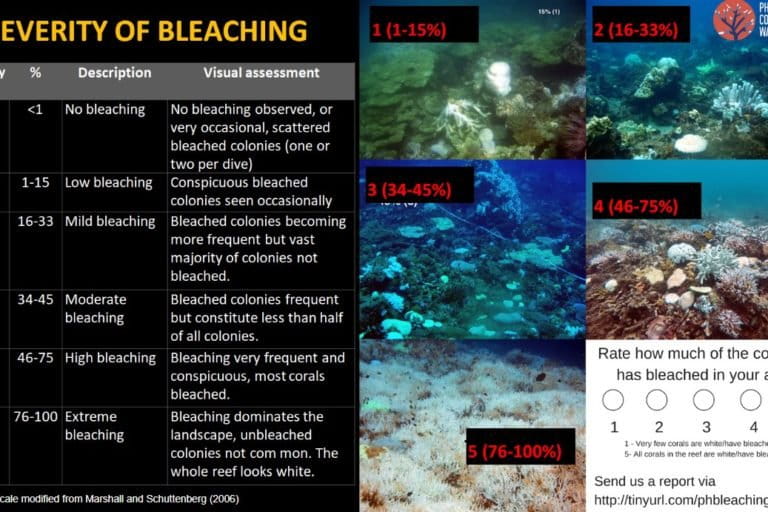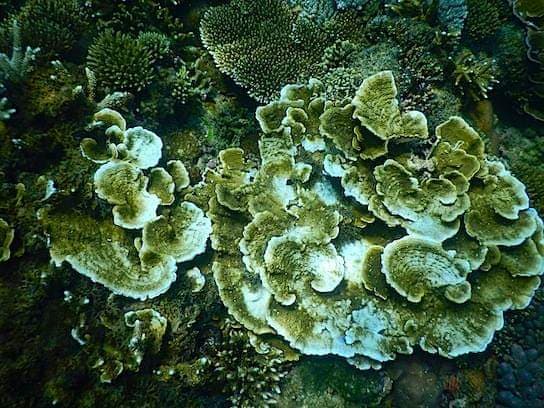https://news.mongabay.com/2020/07/app-harnesses-citizen-power-to-keep-tabs-on-philippines-coral-reefs/
App harnesses citizen power to keep tabs on Philippines’ coral reefs
- A series of coral bleaching events have affected reefs across the Philippines in previous years, and this year alone 11 such incidents have been reported.
- But bleached reefs aren’t necessarily dead, with some still able to recover if they are resilient enough and if no further stressors come into play.
- Given that the Philippines has an estimated 33,500 square kilometers (nearly 13,000 square miles) of reefs, a volunteer group is relying on a small but growing army of citizen scientists to keep track of these bleaching incidents by submitting photos online or through an app.
- Citizen science could also help identify other threats to coral reefs, including crown-of-thorns infestation and disease outbreaks, as well as identify corals that are more resilient.
MANILA — On June 8, an evidence of coral bleaching in a colony of corals was captured by diver and bleach patroller Dina Mae Rañises in Taklong Island National Marine Reserve in the central Philippines.
Less than two weeks later, diver Jessie Fronda Delos Reyes reported a more severe level of coral bleaching occurring in Batangas, a three–hour drive south of Manila. Delos Reyes, a local team leader with the Reef Check EcoDiver program, which trains people to participate in reef-monitoring activities, had noticed signs of bleaching among the Acropora and Montipora corals during one of his dives a month earlier. When he returned a few more times, the situation had rapidly worsened.
Delos Reyes’s report is one of 11 on coral bleaching received this year by Philippine Coral Bleaching Watch (PCBW), a group of volunteers ranging from marine specialists to divers who share the goal of saving the country’s coral reefs. It’s a number the group expects to go up once divers are no longer restricted by the quarantine restrictions imposed in response to the COVID-19 pandemic.
Coral bleaching isn’t new to the Philippines. Between 2009 and 2010, an estimated 95% of corals were left dead by a massive bleaching incident caused by a severe El Niño ocean-warming event.

The Maliao reef off the popular dive spot of Taytay in the country’s west was among the affected areas in 2010. In just two months, the stony Acropora corals of the reef died, causing irreversible damage to the area there.
The ramifications of climate change are clear: If water temperatures continue to go up, the chances of survival for coral reefs go down.
But it’s not easy to keep track of coral bleaching events in the Philippines, which has more than 36,000 kilometers (22,400 miles) of coastline and an estimated coral reef area of around 10,750-33,500 square kilometers (4,150-12,900 square miles). PCBW says it needs all the help it can get to monitor these underwater rainforests and identify coral reefs that show signs of bleaching or other stressors such as crown-of-thorn infestations or other diseases.
This is where citizen science comes in.
Formed in 2010, PCBW has a stated goal of raising public awareness about the state of coral reefs in the Philippines.
Divers are encouraged to take panoramic photos of corals and submit a report online or through a mobile app. Once PCBW receives a report, it cross-checks with bleaching alerts from the U.S. National Oceanic and Atmospheric Administration (NOAA) to rule out coral loss caused by other stressors such as crown-of-thorns predation, Drupella rock snail infestations, or other diseases.
“The ’verified’ reports are then consolidated in a database, which we then summarize and analyze to determine the severity and extent of coral bleaching in the Philippines,” says Milidel Quibilan, a coral reef ecologist. “The information derived is what we share through our social media page and what we report during press conferences. When we are given the opportunity, we also present these results during national and international marine-related conferences.”
To date, the group has received more than 500 reports from more than 100 citizen scientists since the initiative was launched. The app, introduced in 2018, has helped make it easier for volunteers to submit reports that give a visual account of the state of Philippine corals. In some reports, only a small coral colony will show signs of bleaching, while in others, the damage is more widespread.
While the alarm has been raised, bleaching events aren’t necessarily a death sentence for these so-called sentinels of the sea. There’s still a chance that corals can recover if they’re able to reacquire their symbiotic algae, or zooxanthellae, which they tend to expel under thermal stress, Quibilan says.

“The problem is, with the prolonged exposure to high temperatures, they do not reacquire their zooxanthellae,” Quibilan says. “As a result, the corals simply starve, die, and [become] overgrown with more competitive and opportunistic algae.”
There is no quick fix here as bleaching is a natural response to unfavorable environmental conditions. “What we can do is to naturally help them recover quickly by not adding to their already stressed condition,” Quibilan says.
There is still so much scientists can learn about corals, but right now, knowing which ones are more resilient to bleaching can help them increase the chances of the ecosystem’s survival.
But not all corals are created equal. Some reefs, including in Anilao and the Verde Island Passage, both in the central province of Batangas, have shown signs of resilience following past bleaching events — showing that, despite the thermal stress, corals have the capacity to recover.

“We are encouraging people to not just submit coral bleaching reports, but reports of coral reefs in the country that are still thriving despite exposure to repeated coral bleaching events in the past,” Quibilan says.
Once resilient reefs are identified, the strategy to protect reefs can be more streamlined. In the future, these “reefs of hope” may be reproduced once the climate becomes more stable. General mitigation, repair and adaptation strategies may be considered too, but they tend to be more costly and, in some cases, not as effective in the long run. Some coral reef scientists are also trying to come up with a “super coral,” one that can withstand changing ocean conditions, but there is no guarantee that there will be results any time soon.
“But of course, if we can afford it and have the capacity, we should try to implement all of these strategies at the same time to get the most impact,” Quibilan says.
Philippine reefs have suffered three major global bleaching events in recent decades: in 1998, 2010 and 2016. And as long as water temperatures keep rising, more bleaching will occur. For millions of Filipinos who are heavily dependent on coral reefs for their food, livelihoods, and coastal protection, the consequences of coral bleaching aren’t just tied to their present, but also their future.

Despite the seemingly grim trajectory and the PCBW’s limited resources — three people actively managing the day-to-day operations at present, and the rest only called in to help during events — the group says it’s determined to fight the good fight, having grown its Facebook community to more than 6,000 followers.
“Through traditional and social media, we are given the opportunity to inform the general public about what coral bleaching is, why it is happening, why it matters to us here in the Philippines, and what we can do about it,” Quibilan says.
“I think we have gone a long way since 2010,” she adds. “Unlike before, when this was only a concern of coral reef scientists and the like, we are now able to reach more people and engage them in discussions.”
Keeping the conversation going is not the only way the community is making waves.
Saving the reefs is a concerted effort. Currently, PCBW works with the Department of Environment and Natural Resources Biodiversity Management Bureau (DENR-BMB) to maintain the online reporting platform for coral bleaching. They’ve also collaborated to create a National Coral Bleaching Response Plan and drafted guidelines for field offices in the event of a coral bleaching incident. PCBW has also worked with other environmental groups, like Greenpeace Philippines and Rare Philippines, to help raise awareness about coral bleaching.

“Since we can’t go back to the way things were, we now have the chance to build a better future, to ensure our own survival,” Quibilan says. “And the big part of this is making sure that our oceans and life-giving ecosystems like coral reefs remain vibrant and healthy, so that we can continue to enjoy the benefits derived from them.”
She says nature’s resilience may yet surprise us. “We have to remember that corals are very special — they have evolved to be very simple in terms of their anatomy, and yet very complex in their life history strategies and interactions with other marine organisms,” Quibilan says. “I don’t want to count them out just yet.”
Related stories:
Banner image of Philippine coral reefs in the Verde Island Passage, the centre of the center of the world’s marine biodiversity, located in the Philippines. Image by Jett Britnell/Coral Reef Image Bank
FEEDBACK: Use this form to send a message to the author of this post. If you want to post a public comment, you can do that at the bottom of the page.
沒有留言:
張貼留言